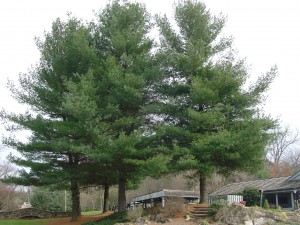Environmental and pathogenic problems continue to take their toll on Eastern White Pine (Pinus strobus). This valued landscape and lumber tree is native in the Eastern U.S. and Canada (USDA zones 3-8). Climate change is likely contributing to recent losses of white pines due a number of serious disease and pest problems that are reducing tree numbers.
Pests:
A decade ago, pine beetles devastated large populations of white pines in the Southeastern U.S. Injury symptoms closely mimicked drought injury. Beetles lay their eggs and larvae tunnel into the branch wood. Needles turn straw brown, often showing up at tops of trees. Summer droughts have made infestations more severe.
White Pine weevil is another serious pest. Weevil larvae feed on the sapwood and kill the top growth (leaders). A common symptom is presence of pearl white resin leakage on limbs.
Pine Sawfly larvae (caterpillars) can cause rapid defoliation of branches if left unchecked; they feed in groups on the needles.
Pine needle miner larvae feed inside needles causing them to turn yellow and dry up.
Two kinds of scale insects feed on needles: pine needle scale (white, elongated scale) and pine tortoise scale (brown colored). Horticultural light oils are very effective applied in late winter.
Diseases:
White Pine Blister Rust. In some areas of the U.S., farmers and home gardeners are prohibited by law to grow black currants, which are alternate hosts for this disease. Red currants should not be grown within 300 feet of white pines. Infected branches may be pruned off. Some varieties of white pine are resistant to this disease.
White Pine Decline describes the slow decline of pine trees. Needles turn pale green, shrivel, and ooze sap. The entire tree is usually affected and mimics a root system. Causes seem to be a combination of environmental stresses, and shows up worse in dry clay soils. Tree usually does not recover and dies within 4-6 weeks.
Additionally, white pines are susceptible to urban air pollutants including ozone and road salt. Limbs are susceptible to ice breakage.


 Posted in
Posted in 
